This article was co-authored by Neal Blitz, DPM, FACFAS and by wikiHow staff writer, Amy Bobinger. Dr. Neal Blitz is a Podiatrist and Foot & Ankle Surgeon who runs private practices in New York City and in Beverly Hills, California. Dr. Blitz is “The Bunion King®” and is the creator of the Bunionplasty® Procedure (plastic surgery for bunions) which has revolutionized bunion surgery. He has over 17 years of podiatric experience and specializes in minimally invasive foot and ankle surgery. Dr. Blitz received his DPM from the New York College of Podiatric Medicine, then completed a residency focused on Elective & Reconstructive Foot & Ankle Surgery at the Swedish Medical Center, and was awarded an AO Trauma fellowship in Dresden, Germany, focused on trauma and reconstructive techniques. He is board certified in Foot Surgery and Reconstructive Rearfoot & Ankle Surgery and is also a Diplomate of the American Board of Foot & Ankle Surgery and a fellow of the American College of Foot & Ankle Surgeons (FACFAS).
There are 8 references cited in this article, which can be found at the bottom of the page.
This article has been viewed 443,633 times.
Sometimes, when you stretch a certain way, you may notice a popping or cracking noise in your joints. If you have ankle pain and soreness, stretching so that your ankle deliberately cracks can sometimes give you the relief you need. Cracking your joints is perfectly normal and is not dangerous, although the sound can sometimes bother people who are nearby.[1] If you want to crack your ankle, try one of these stretches, but stop right away if you experience pain while you’re doing them.
Steps
Pointing Your Toes
-
1Stand up straight with your foot held out in front of you. Your foot should be slightly off the floor with enough room to flex it in different directions. About 2–3 in (5.1–7.6 cm) should be enough.[2]
- If you feel unsteady, place your hand on a wall or a piece of sturdy furniture to help hold your balance.
- If you need to, you can also do this exercise sitting down.
-
2Point your toes forward as much as you can for about 15 seconds. Keep your knee straight, and stretch your toes forward either as much as you can or until you feel discomfort. After about 15 seconds, relax your foot back to the neutral position.[3]
- If your ankle doesn’t pop, you can try again or stretch your ankle another direction.
Advertisement -
3Repeat by pulling your toes back and turning your ankle from side to side. After each move, hold your foot in place for 15 seconds, then relax. Once your ankle pops, you can stop, or you can continue the stretches if you want to loosen your ankle even more.[4]
- Your ankle will only pop about once every 20 minutes, so there’s no need to continue stretching unless you want to.
-
4Try rotating your ankle in circles if it didn’t pop already. Try 5 circles each of small, medium, and large rotations, first in one direction, then the other.[5] If the stretches didn’t crack your ankle, the rotations may help it to pop.[6]
- If your ankle doesn’t pop after the rotations, let it rest before trying another method.
- Keep in mind that even if your ankles don't pop, these stretches are still good for improving the range of motion in your ankles.[7]
-
5Switch legs and repeat if you want to crack both ankles. Sometimes, only one of your ankles might need to be cracked, in which case, you don’t have to switch to the other side. However, if you’ve loosened up the muscles in one ankle, it might be best to stretch the other one as well, even if it doesn’t crack.[8]
Tracing the Alphabet
-
1Sit in a chair so your feet don't touch the floor. Make sure you’re well-balanced and comfortable. You’ll be moving your feet for several minutes, and you don’t want to strain your back.[9]
- If you need to, shift so your weight is resting on the foot that’s still on the ground.
- You may be more comfortable in a chair with arms, so you can use your hands to help support your weight.
-
2Lift one leg into the air about 2–3 in (5.1–7.6 cm) off the ground. For this exercise, you’ll be rotating your ankle in different directions until it cracks. Leave yourself plenty of room to move your foot around without running into the floor. [10]
-
3Trace the alphabet with your foot, leading with your big toe. By tracing the alphabet, you’ll be forcing your ankle into a variety of different angles and movements that you might not normally perform. One of these motions may be just the thing to crack your ankle.[11]
- Repeat the alphabet 1-3 times as necessary.
- This works a lot of the external and intrinsic muscles that control your ankle and foot.[12]
-
4Switch and repeat with the other foot. If you want to crack both of your ankles, shift your weight in your chair, return the first foot to the floor, and lift the other foot. Even if your ankle doesn’t crack, it’s always a good idea to limber up both sides of your body evenly.[13]
Aids
-
1Sit with your legs crossed and put one foot on the opposite knee. For this exercise, you’ll be most comfortable—and stable—if you sit on the floor. If sitting directly on the floor is uncomfortable, you can sit on a cushion or a pile of blankets.[14]
- You may also be able to perform this exercise sitting on a bed or a couch.
-
2Pick one foot up and place it on top of the opposite knee. This will be a sort of modified lotus pose. The outside of your foot should rest on the top of the opposite knee. This position should feel comfortable and not strained.[15]
- If you feel any discomfort in your ankle, knee, or lower back, stop right away.
-
3Place one hand on top of your ankle and grasp your foot with the other. You’ll be using your hands to manipulate your ankle, so be sure you have a good grip on your foot. Hold it firmly, but do not squeeze so tightly that it’s uncomfortable.[16]
-
4Guide your foot in circular rotations, first one way, then the other. Make sure you stretch your ankle gently, in slow circles, keeping your ankle extended as far as you comfortably can. However, don’t force your ankle to the point of discomfort.[17]
- If you need to, you can repeat on the other foot.
Expert Q&A
-
QuestionHow can I stretch my ankles?
 Neal Blitz, DPM, FACFASDr. Neal Blitz is a Podiatrist and Foot & Ankle Surgeon who runs private practices in New York City and in Beverly Hills, California. Dr. Blitz is “The Bunion King®” and is the creator of the Bunionplasty® Procedure (plastic surgery for bunions) which has revolutionized bunion surgery. He has over 17 years of podiatric experience and specializes in minimally invasive foot and ankle surgery. Dr. Blitz received his DPM from the New York College of Podiatric Medicine, then completed a residency focused on Elective & Reconstructive Foot & Ankle Surgery at the Swedish Medical Center, and was awarded an AO Trauma fellowship in Dresden, Germany, focused on trauma and reconstructive techniques. He is board certified in Foot Surgery and Reconstructive Rearfoot & Ankle Surgery and is also a Diplomate of the American Board of Foot & Ankle Surgery and a fellow of the American College of Foot & Ankle Surgeons (FACFAS).
Neal Blitz, DPM, FACFASDr. Neal Blitz is a Podiatrist and Foot & Ankle Surgeon who runs private practices in New York City and in Beverly Hills, California. Dr. Blitz is “The Bunion King®” and is the creator of the Bunionplasty® Procedure (plastic surgery for bunions) which has revolutionized bunion surgery. He has over 17 years of podiatric experience and specializes in minimally invasive foot and ankle surgery. Dr. Blitz received his DPM from the New York College of Podiatric Medicine, then completed a residency focused on Elective & Reconstructive Foot & Ankle Surgery at the Swedish Medical Center, and was awarded an AO Trauma fellowship in Dresden, Germany, focused on trauma and reconstructive techniques. He is board certified in Foot Surgery and Reconstructive Rearfoot & Ankle Surgery and is also a Diplomate of the American Board of Foot & Ankle Surgery and a fellow of the American College of Foot & Ankle Surgeons (FACFAS).
Board Certified Podiatrist While you're sitting, make circles with your foot, first one way, then the other. You can also trace the alphabet with your toes while you're sitting. Finally, try putting a dish towel on the floor, then pick it up with your toes and move it from one spot to another.
While you're sitting, make circles with your foot, first one way, then the other. You can also trace the alphabet with your toes while you're sitting. Finally, try putting a dish towel on the floor, then pick it up with your toes and move it from one spot to another.
Warnings
- Stop right away and consult your doctor if any of these exercises are painful.⧼thumbs_response⧽
References
- ↑ https://www.health.harvard.edu/pain/does-knuckle-cracking-cause-arthritis
- ↑ https://healthfully.com/crack-ankle-2241595.html
- ↑ https://www.verywellhealth.com/ankle-sprain-stretches-2696356
- ↑ https://www.verywellhealth.com/ankle-sprain-stretches-2696356
- ↑ Neal Blitz, DPM, FACFAS. Board Certified Podiatrist. Expert Interview. 22 April 2020.
- ↑ https://www.activekids.com/volleyball/articles/6-stretches-to-prevent-ankle-injuries/slide-3
- ↑ Neal Blitz, DPM, FACFAS. Board Certified Podiatrist. Expert Interview. 22 April 2020.
- ↑ https://healthfully.com/crack-ankle-2241595.html
- ↑ https://orthoinfo.aaos.org/en/recovery/foot-and-ankle-conditioning-program/
- ↑ https://orthoinfo.aaos.org/en/recovery/foot-and-ankle-conditioning-program/
- ↑ https://www.uofmhealth.org/health-library/te7604
- ↑ Neal Blitz, DPM, FACFAS. Board Certified Podiatrist. Expert Interview. 22 April 2020.
- ↑ https://orthoinfo.aaos.org/en/recovery/foot-and-ankle-conditioning-program/
- ↑ https://healthfully.com/crack-ankle-2241595.html
- ↑ https://www.froedtert.com/foot-ankle/treatment/stretches
- ↑ https://www.froedtert.com/foot-ankle/treatment/stretches
- ↑ https://healthfully.com/crack-ankle-2241595.html
About This Article
To crack your ankle, stand up straight and hold your foot out in front of you. Make sure it's at least 2 to 3 centimeters off the ground, so you have enough room to flex your foot in different directions until your ankle pops. If that doesn't work, try sitting still with your knees straight and your toes pointed forward as much as possible. After 15 seconds, return your foot to its neutral position, at which point your ankle should pop. You could also try a stretch where you sit with your toes pulled back and turn your ankle from side to side, holding your foot in place for 15 seconds after each turn. If your ankle still hasn't popped, rotate your foot in small, medium, and large rotations, first counterclockwise, then clockwise. For more advice, like how to use aids and exercises to crack your ankle, read on.

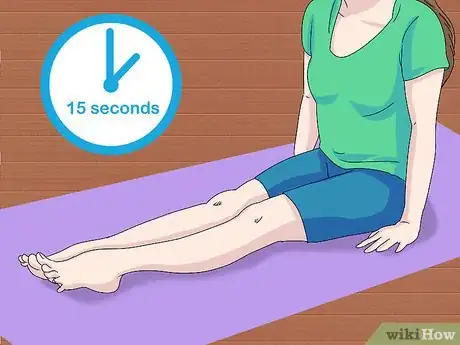
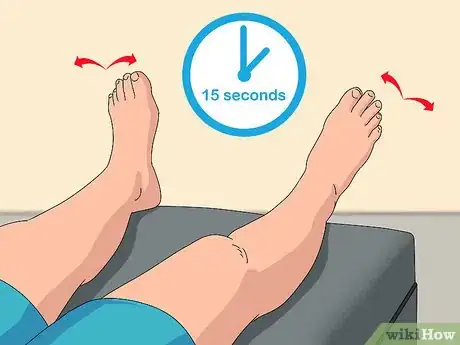
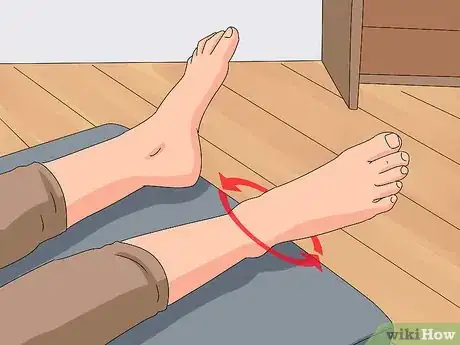


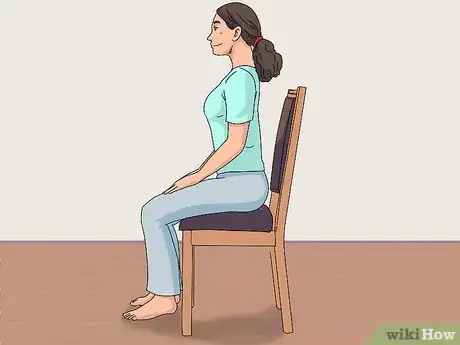
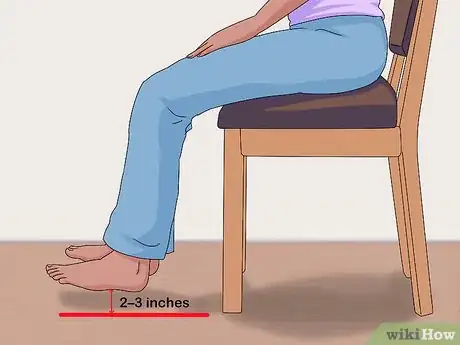


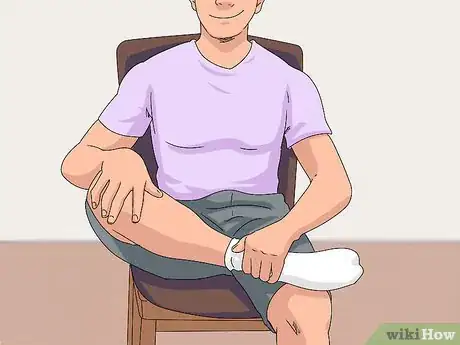
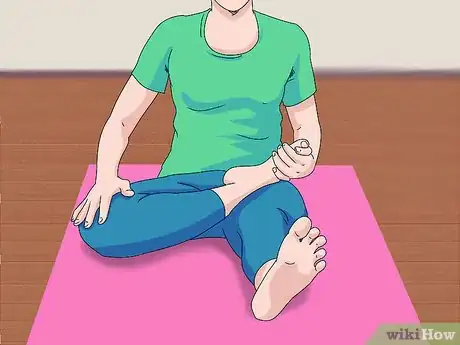
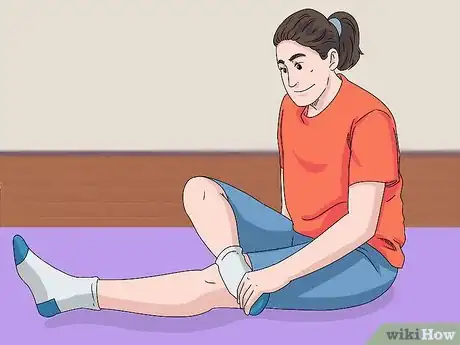
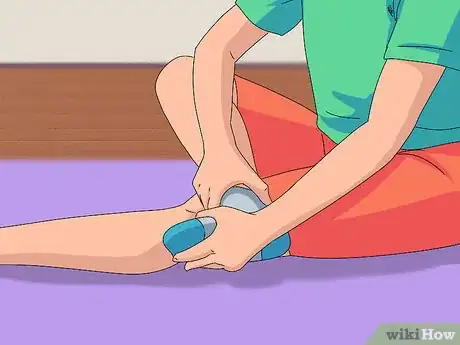






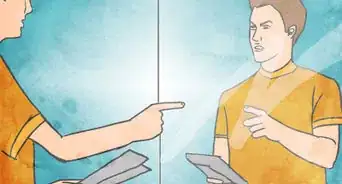


















































Medical Disclaimer
The content of this article is not intended to be a substitute for professional medical advice, examination, diagnosis, or treatment. You should always contact your doctor or other qualified healthcare professional before starting, changing, or stopping any kind of health treatment.
Read More...